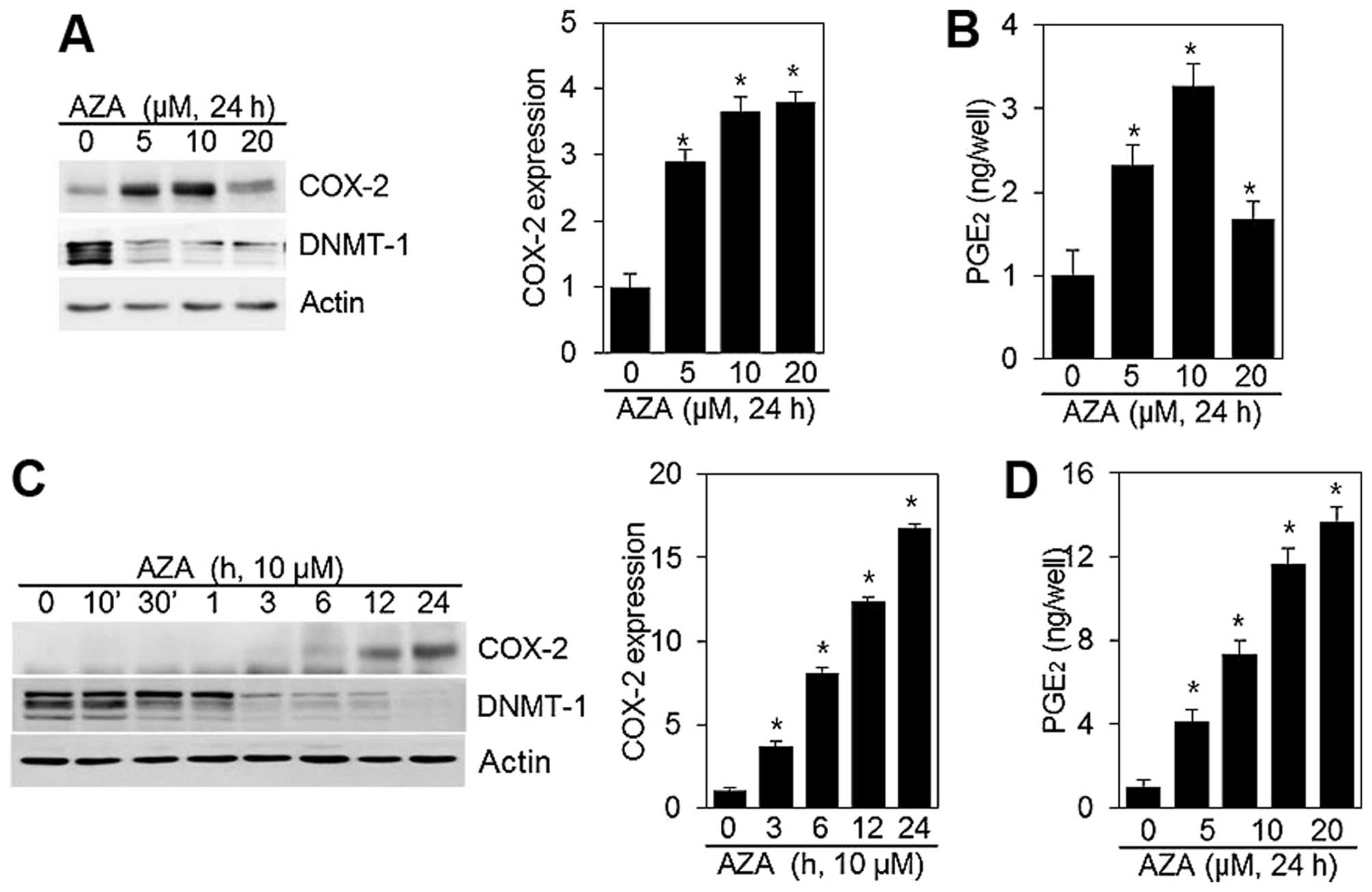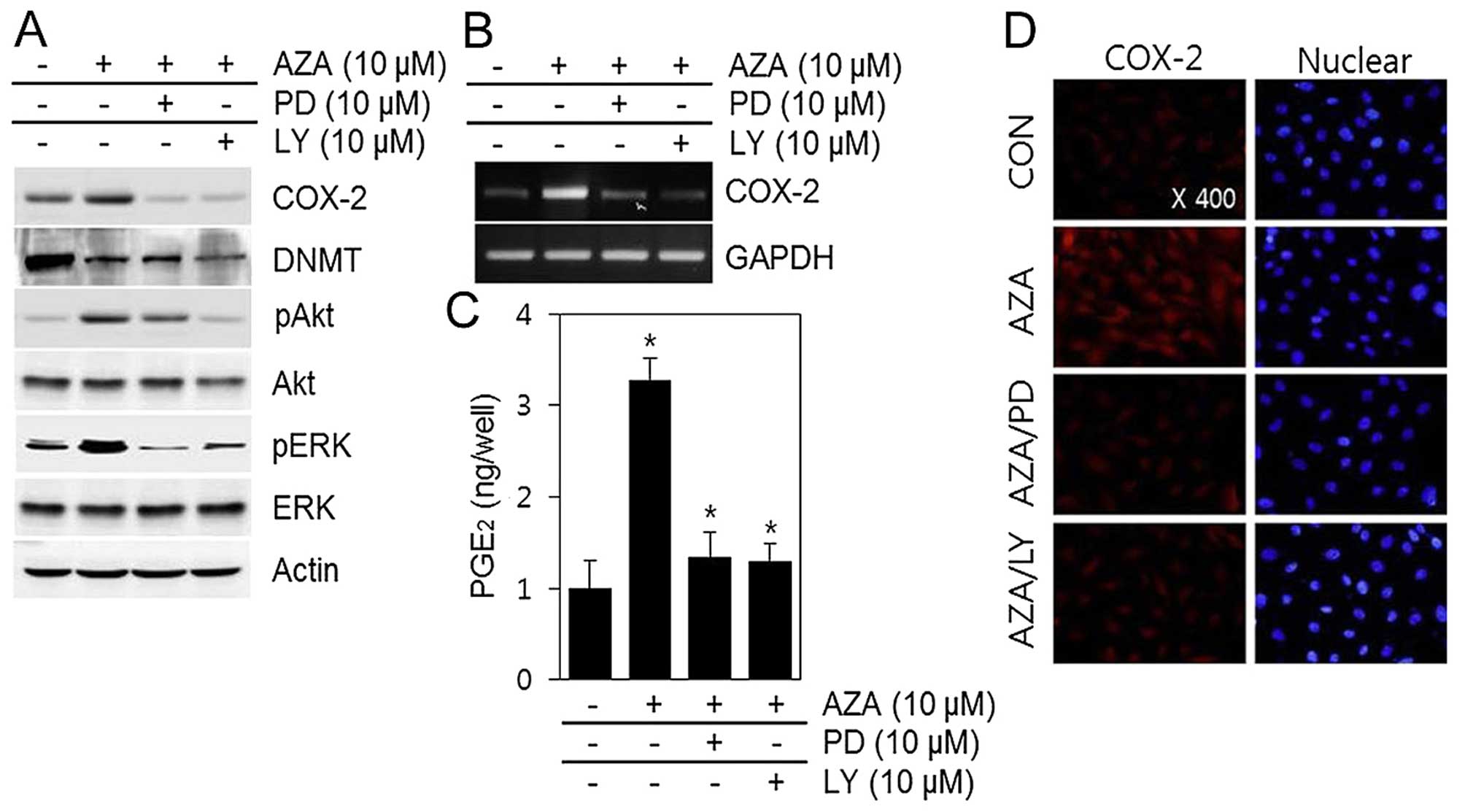|
1
|
Papagelopoulos PJ, Galanis E, Frassica FJ,
Sim FH, Larson DR and Wold LE: Primary fibrosarcoma of bone.
outcome after primary surgical treatment. Clin Orthop Relat Res.
373:88–103. 2000. View Article : Google Scholar : PubMed/NCBI
|
|
2
|
Baylin SB and Jones PA: A decade of
exploring the cancer epigenome - biological and translational
implications. Nat Rev Cancer. 11:726–734. 2011. View Article : Google Scholar : PubMed/NCBI
|
|
3
|
Szyf M: The role of DNA methyltransferase
1 in growth control. Front Biosci. 6:D599–D609. 2001. View Article : Google Scholar : PubMed/NCBI
|
|
4
|
Stresemann C, Bokelmann I, Mahlknecht U
and Lyko F: Azacytidine causes complex DNA methylation responses in
myeloid leukemia. Mol Cancer Ther. 7:2998–3005. 2008. View Article : Google Scholar : PubMed/NCBI
|
|
5
|
Voso MT, Breccia M, Lunghi M, Poloni A,
Niscola P, Finelli C, Bari A, Musto P, Zambello R, Fianchi L, et
al: Rapid loss of response after withdrawal of treatment with
azacitidine: A case series in patients with higher-risk
myelodysplastic syndromes or chronic myelomonocytic leukemia. Eur J
Haematol. 90:345–348. 2013. View Article : Google Scholar : PubMed/NCBI
|
|
6
|
Silverman LR, Fenaux P, Mufti GJ, Santini
V, Hellström-Lindberg E, Gattermann N, Sanz G, List AF, Gore SD and
Seymour JF: Continued azacitidine therapy beyond time of first
response improves quality of response in patients with higher-risk
myelodysplastic syndromes. Cancer. 117:2697–2702. 2011. View Article : Google Scholar : PubMed/NCBI
|
|
7
|
Kaminskas E, Farrell A, Abraham S, Baird
A, Hsieh LS, Lee SL, Leighton JK, Patel H, Rahman A, Sridhara R, et
al: Approval summary: Azacitidine for treatment of myelodysplastic
syndrome subtypes. Clin Cancer Res. 11:3604–3608. 2005. View Article : Google Scholar : PubMed/NCBI
|
|
8
|
Feinberg AP, Gehrke CW, Kuo KC and Ehrlich
M: Reduced genomic 5-methylcytosine content in human colonic
neoplasia. Cancer Res. 48:1159–1161. 1988.PubMed/NCBI
|
|
9
|
Shteper PJ, Zcharia E, Ashhab Y, Peretz T,
Vlodavsky I and Ben-Yehuda D: Role of promoter methylation in
regulation of the mammalian heparanase gene. Oncogene.
22:7737–7749. 2003. View Article : Google Scholar : PubMed/NCBI
|
|
10
|
Wu KK: Cyclooxygenase 2 induction:
Molecular mechanism and pathophysiologic roles. J Lab Clin Med.
128:242–245. 1996. View Article : Google Scholar : PubMed/NCBI
|
|
11
|
Bauer AK, Dwyer-Nield LD and Malkinson AM:
High cyclo-oxygenase 1 (COX-1) and cyclooxygenase 2 (COX-2)
contents in mouse lung tumors. Carcinogenesis. 21:543–550. 2000.
View Article : Google Scholar : PubMed/NCBI
|
|
12
|
Nurmi JT, Puolakkainen PA and Rautonen NE:
Intron 1 retaining cyclooxygenase 1 splice variant is induced by
osmotic stress in human intestinal epithelial cells. Prostaglandins
Leukot Essent Fatty Acids. 73:343–350. 2005. View Article : Google Scholar : PubMed/NCBI
|
|
13
|
Chell S, Kaidi A, Williams AC and
Paraskeva C: Mediators of PGE2 synthesis and signalling downstream
of COX-2 represent potential targets for the prevention/treatment
of colorectal cancer. Biochim Biophys Acta. 1766:104–119.
2006.PubMed/NCBI
|
|
14
|
Prescott SM and Fitzpatrick FA:
Cyclooxygenase-2 and carcinogenesis. Biochim Biophys Acta.
1470:M69–M78. 2000.PubMed/NCBI
|
|
15
|
Hanahan D and Weinberg RA: Hallmarks of
cancer: The next generation. Cell. 144:646–674. 2011. View Article : Google Scholar : PubMed/NCBI
|
|
16
|
Tang X, Sun YJ, Half E, Kuo MT and
Sinicrope F: Cyclooxygenase-2 overexpression inhibits death
receptor 5 expression and confers resistance to tumor necrosis
factor-related apoptosis-inducing ligand-induced apoptosis in human
colon cancer cells. Cancer Res. 62:4903–4908. 2002.PubMed/NCBI
|
|
17
|
Totzke G, Schulze-Osthoff K and Janicke
RU: Cyclooxygenase-2 (COX-2) inhibitors sensitize tumor cells
specifically to death receptor-induced apoptosis independently of
COX-2 inhibition. Oncogene. 22:8021–8030. 2003. View Article : Google Scholar : PubMed/NCBI
|
|
18
|
Pockaj BA, Basu GD, Pathangey LB, Gray RJ,
Hernandez JL, Gendler SJ and Mukherjee P: Reduced T-cell and
dendritic cell function is related to cyclooxygenase-2
overexpression and pros-taglandin E2 secretion in patients with
breast cancer. Ann Surg Oncol. 11:328–339. 2004. View Article : Google Scholar : PubMed/NCBI
|
|
19
|
Castellone MD, Teramoto H, Williams BO,
Druey KM and Gutkind JS: Prostaglandin E2 promotes colon cancer
cell growth through a gs-axin-beta-catenin signaling axis. Science.
310:1504–1510. 2005. View Article : Google Scholar : PubMed/NCBI
|
|
20
|
Kinugasa Y, Hatori M, Ito H, Kurihara Y,
Ito D and Nagumo M: Inhibition of cyclooxygenase-2 suppresses
invasiveness of oral squamous cell carcinoma cell lines via
down-regulation of matrix metalloproteinase-2 and CD44. Clin Exp
Metastasis. 21:737–745. 2005. View Article : Google Scholar : PubMed/NCBI
|
|
21
|
Gallo O, Franchi A, Magnelli L, Sardi I,
Vannacci A, Boddit V, Chiarugi V and Masini E: Cyclooxygenase-2
pathway correlates with VEGF expression in head and neck cancer.
implications for tumor angiogenesis and metastasis. Neoplasia.
3:53–61. 2001. View Article : Google Scholar : PubMed/NCBI
|
|
22
|
Masferrer JL, Leahy KM, Koki AT, Zweifel
BS, Settle SL, Woerner BM, Edwards DA, Flickinger AG, Moore RJ and
Seibert K: Antiangiogenic and antitumor activities of
cyclooxy-genase-2 inhibitors. Cancer Res. 60:1306–1311.
2000.PubMed/NCBI
|
|
23
|
Tsujii M, Kawano S and DuBois RN:
Cyclooxygenase-2 expression in human colon cancer cells increases
metastatic potential. Proc Natl Acad Sci USA. 94:3336–3340. 1997.
View Article : Google Scholar : PubMed/NCBI
|
|
24
|
Byun JH, Lee MA, Roh SY, Shim BY, Hong SH,
Ko YH, Ko SJ, Woo IS, Kang JH, Hong YS, et al: Association between
cyclooxygenase-2 and matrix metalloproteinase-2 expression in
non-small cell lung cancer. Jpn J Clin Oncol. 36:263–268. 2006.
View Article : Google Scholar : PubMed/NCBI
|
|
25
|
Eberhart CE, Coffey RJ, Radhika A,
Giardiello FM, Ferrenbach S and DuBois RN: Up-regulation of
cyclooxygenase 2 gene expression in human colorectal adenomas and
adenocarcinomas. Gastroenterology. 107:1183–1188. 1994.PubMed/NCBI
|
|
26
|
Ristimaki A, Honkanen N, Jankala H,
Sipponen P and Harkonen M: Expression of cyclooxygenase-2 in human
gastric carcinoma. Cancer Res. 57:1276–1280. 1997.PubMed/NCBI
|
|
27
|
Wolff H, Saukkonen K, Anttila S,
Karjalainen A, Vainio H and Ristimaki A: Expression of
cyclooxygenase-2 in human lung carcinoma. Cancer Res. 58:4997–5001.
1998.PubMed/NCBI
|
|
28
|
Liu XH and Rose DP: Differential
expression and regulation of cyclooxygenase-1 and -2 in two human
breast cancer cell lines. Cancer Res. 56:5125–5127. 1996.PubMed/NCBI
|
|
29
|
Toyota M, Shen L, Ohe-Toyota M, Hamilton
SR, Sinicrope FA and Issa JP: Aberrant methylation of the
cyclooxygenase 2 CpG island in colorectal tumors. Cancer Res.
60:4044–4048. 2000.PubMed/NCBI
|
|
30
|
Huang L, Zhang KL, Li H, Chen X-Y, Kong
Q-Y, Sun Y, Gao X, Guan H-W and Liu J: Infrequent COX-2 expression
due to promoter hypermethylation in gastric cancers in Dalian,
China. Hum Pathol. 37:1557–1567. 2006. View Article : Google Scholar : PubMed/NCBI
|
|
31
|
Ramsay RG, Ciznadija D, Vanevski M and
Mantamadiotis T: Transcriptional regulation of cyclo-oxygenase
expression: Three pillars of control. Int J Immunopathol Pharmacol.
16:59–67. 2003.PubMed/NCBI
|
|
32
|
Tanabe T and Tohnai N: Cyclooxygenase
isozymes and their gene structures and expression. Prostaglandins
Other Lipid Mediat. 68–69:95–114. 2002. View Article : Google Scholar
|
|
33
|
St-Germain ME, Gagnon V, Mathieu I, Parent
S and Asselin E: Akt regulates COX-2 mRNA and protein expression in
mutated-PTEN human endometrial cancer cells. Int J Oncol.
24:1311–1324. 2004.PubMed/NCBI
|
|
34
|
Takeda K, Kanekura T and Kanzaki T:
Negative feedback regulation of phosphatidylinositol 3-kinase/akt
pathway by over-expressed cyclooxygenase-2 in human epidermal
cancer cells. J Dermatol. 31:516–523. 2004. View Article : Google Scholar : PubMed/NCBI
|
|
35
|
Detich N, Hamm S, Just G, Knox JD and Szyf
M: The methyl donor S-adenosylmethionine inhibits active
demethylation of DNA: A candidate novel mechanism for the
pharmacological effects of S-adenosylmethionine. J Biol Chem.
278:20812–20820. 2003. View Article : Google Scholar : PubMed/NCBI
|
|
36
|
Minghetti L, Walsh DT, Levi G and Perry
VH: In vivo expression of cyclooxygenase-2 in rat brain following
intraparenchymal injection of bacterial endotoxin and inflammatory
cytokines. J Neuropathol Exp Neurol. 58:1184–1191. 1999. View Article : Google Scholar : PubMed/NCBI
|
|
37
|
Giordano S, Maffe A, Williams TA,
Artigiani S, Gual P, Bardelli A, Basilico C, Michieli P and
Comoglio PM: Different point mutations in the met oncogene elicit
distinct biological properties. FASEB J. 14:399–406.
2000.PubMed/NCBI
|
|
38
|
Matsuura H, Sakaue M, Subbaramaiah K,
Kamitani H, Eling TE, Dannenberg AJ, Tanabe T, Inoue H, Arata J and
Jetten AM: Regulation of cyclooxygenase-2 by interferon gamma and
transforming growth factor alpha in normal human epidermal
keratinocytes and squamous carcinoma cells. role of
mitogen-activated protein kinases. J Biol Chem. 274:29138–29148.
1999. View Article : Google Scholar : PubMed/NCBI
|
|
39
|
DuBois RN, Shao J, Tsujii M, Sheng H and
Beauchamp RD: G1 delay in cells overexpressing prostaglandin
endoperoxide synthase-2. Cancer Res. 56:733–737. 1996.PubMed/NCBI
|
|
40
|
Trifan OC, Smith RM, Thompson BD and Hla
T: Overexpression of cyclooxygenase-2 induces cell cycle arrest.
evidence for a prostaglandin-independent mechanism. J Biol Chem.
274:34141–34147. 1999. View Article : Google Scholar : PubMed/NCBI
|
|
41
|
Santoro MG, Philpott GW and Jaffe BM:
Inhibition of tumour growth in vivo and in vitro by prostaglandin
E. Nature. 263:777–779. 1976. View Article : Google Scholar : PubMed/NCBI
|
|
42
|
Shimakura S and Boland CR: Eicosanoid
production by the human gastric cancer cell line AGS and its
relation to cell growth. Cancer Res. 52:1744–1749. 1992.PubMed/NCBI
|
|
43
|
DeRubertis FR, Craven PA and Saito R:
16,16-dimethyl prostaglandin E2 suppresses the increases in the
proliferative activity of rat colonic epithelium induced by
indomethacin and aspirin. Gastroenterology. 89:1054–1063.
1985.PubMed/NCBI
|
|
44
|
Prasad KN: Morphological differentiation
induced by prostaglandin in mouse neuroblastoma cells in culture.
Nat New Biol. 236:49–52. 1972. View Article : Google Scholar : PubMed/NCBI
|
|
45
|
Sheng H, Shao J, Washington MK and DuBois
RN: Prostaglandin E2 increases growth and motility of colorectal
carcinoma cells. J Biol Chem. 276:18075–18081. 2001. View Article : Google Scholar : PubMed/NCBI
|
|
46
|
Pai R, Soreghan B, Szabo IL, Pavelka M,
Baatar D and Tarnawski AS: Prostaglandin E2 transactivates EGF
receptor: A novel mechanism for promoting colon cancer growth and
gastrointestinal hypertrophy. Nat Med. 8:289–293. 2002. View Article : Google Scholar : PubMed/NCBI
|
|
47
|
Gweon EJ, Jung JC and Kim SJ: Luteolin
induces inhibition of cell proliferation and COX-2 expression via
ERK pathway in human fibrosarcoma HT1080. Cancer Prev Res (Phila).
17:218–225. 2012.
|
|
48
|
Rashid A and Issa JP: CpG island
methylation in gastroenterologic neoplasia: A maturing field.
Gastroenterology. 127:1578–1588. 2004. View Article : Google Scholar : PubMed/NCBI
|
|
49
|
Akhtar M, Cheng Y, Magno RM, Ashktorab H,
Smoot DT, Meltzer SJ and Wilson KT: Promoter methylation regulates
helicobacter pylori-stimulated cyclooxygenase-2 expression in
gastric epithelial cells. Cancer Res. 61:2399–2403. 2001.PubMed/NCBI
|
|
50
|
Mercau ME, Astort F, Giordanino EF,
Martinez Calejman C, Sanchez R, Caldareri L, Repetto EM, Coso OA
and Cymeryng CB: Involvement of PI3K/akt and p38 MAPK in the
induction of COX-2 expression by bacterial lipopolysaccharide in
murine adrenocortical cells. Mol Cell Endocrinol. 384:43–51. 2014.
View Article : Google Scholar : PubMed/NCBI
|
|
51
|
Yu SM and Kim SJ: Production of reactive
oxygen species by withaferin A causes loss of type collagen
expression and COX-2 expression through the PI3K/akt, p38, and JNK
pathways in rabbit articular chondrocytes. Exp Cell Res.
319:2822–2834. 2013. View Article : Google Scholar : PubMed/NCBI
|














